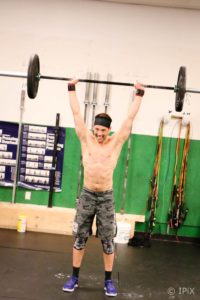From July until the end of September, CrossFit Prototype will be posting a blog per week as part of our Accessory Series. These blog posts will review 1 of the 13 CFP foundational movements (Air Squat, Back Squat, Front Squat, Deadlift, Kettlebell Swing, Pull-Up, Overhead Press, Push Press, Push Jerk, Clean, Snatch & Rowing) and provide tips on accessory exercises to help improve that area of your CrossFit game.

By Joe Black (CF-L2, USAW-L1SP)
The push jerk (also referred to as the power jerk) is arguably one of the hardest movements in CrossFit. It requires the coordination of proper timing, sequencing of movement and overhead mobility. Learning the push jerk can certainly be frustrating, yet it is imperative that you learn how to correctly perform this movement. The push jerk is one of the most efficient ways to put heavy weight overhead and can save your shoulders and back during workouts that require stringing together numerous reps overhead.
How to Push Jerk
Let’s quickly review the push jerk and the points of performance:
- Start with a hip-width stance
- Hands are just outside the shoulders with a full grip on the bar
- Elbows are slightly in front of the bar
- Torso dips straight down
- Hips and legs (ankles & knees) extend rapidly, pushing the barbell up
- Feet move out, arms push under the bar and the bar is received in a partial squat
- Bar stays over the middle of the feet throughout the entire movement
The push jerk has an identical set up to the overhead press and push press. The difference with the push jerk is that once you use your legs to drive the bar up, you need to push yourself under the weight. With this additional step, it should allow you to get under heavier weight!
The funny thing about the push jerk is that when you overthink it, it seems difficult to execute. But under fatigue, most people start to use a push jerk because it ends up being the easiest way to move the weight 🙂
Three Accessory Exercises to Improve Your Push Jerk
Tall Push (Power) Jerk
You may have done or seen the split variation of this movement before. With the tall power jerk, you stand up on the balls of your feet with the barbell lifted off your shoulders and held in front of your forehead. From this position, you pick up your feet, move them out to the sides and press under the bar, landing in a partial squat. This teaches you to quickly move to the receiving position after you hit full extension (hips, knees and ankles are in a straight line).
Try this for sets of 3-5 reps during your warm-up and increase the weight up to 30% of your jerk. This is a technique primer, not something you do for max weight.
Behind the Neck Push (Power) Jerk
One of the more challenging aspects of the push jerk is the dip – the lowering of your torso to load your legs and help drive the weight up overhead. Typically, athletes will have too much of their weight forward during the dip, which makes it extremely difficult to drive the bar straight up. One way to fix this is with behind the neck work. Placing the bar on your back shifts the weight back and allows one to feel what it is like to dip straight down and drive the bar straight up.
Behind the Neck Push Jerks can be included in a warmup for 2-4 sets of 3-5 reps. This is also a great movement to work at heavier loads – establishing a 1-3RM with great technique would have a beneficial carry-over to the traditional push jerk.
Push Jerk Progressions: Overhead Press and Push Press
Sometimes you don’t need to get fancy with accessory movements. Working to improve your overhead press and push press, will have great carry-over to your push jerk. These are progressions for the push jerk. Progressions are movements that build upon one another to help you establish the end movement.
With the overhead press, you are building strength throughout your torso and overhead. With the push press, you are developing explosive leg drive and lock-out strength. If you struggle with the push jerk, work your press and push press with intention, knowing that these are the building blocks to a strong push jerk!
